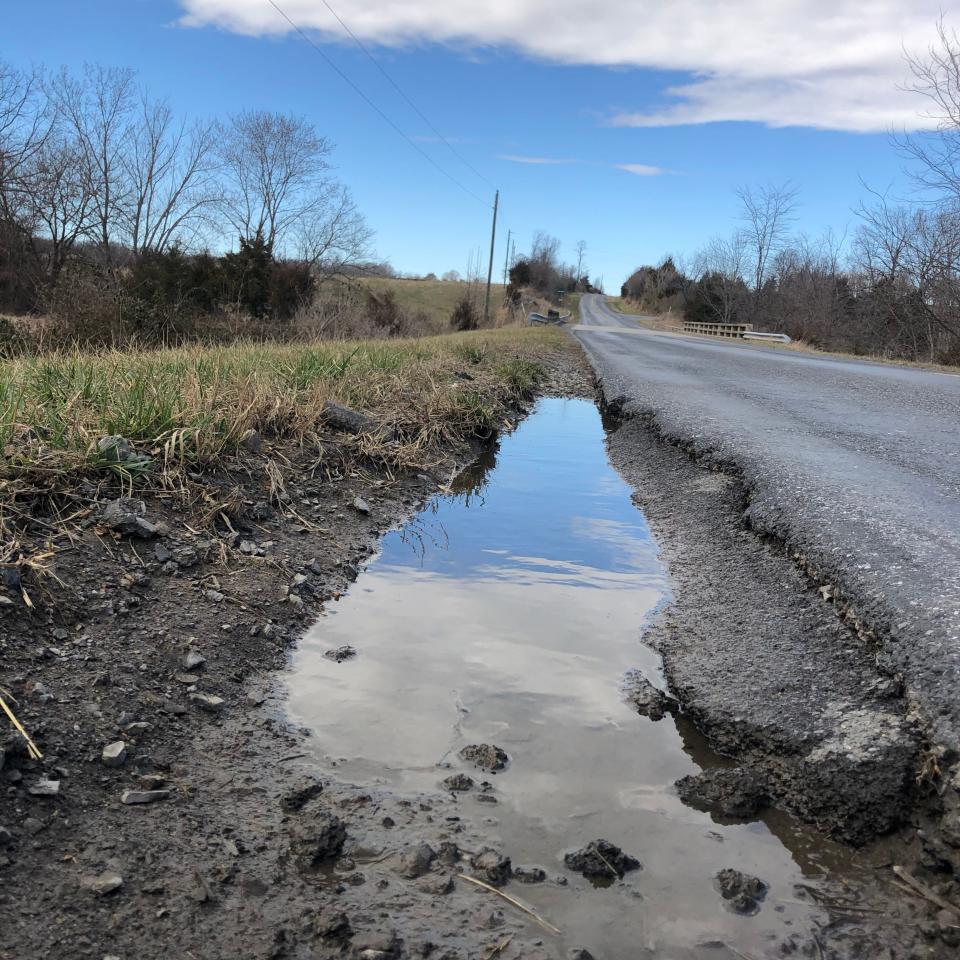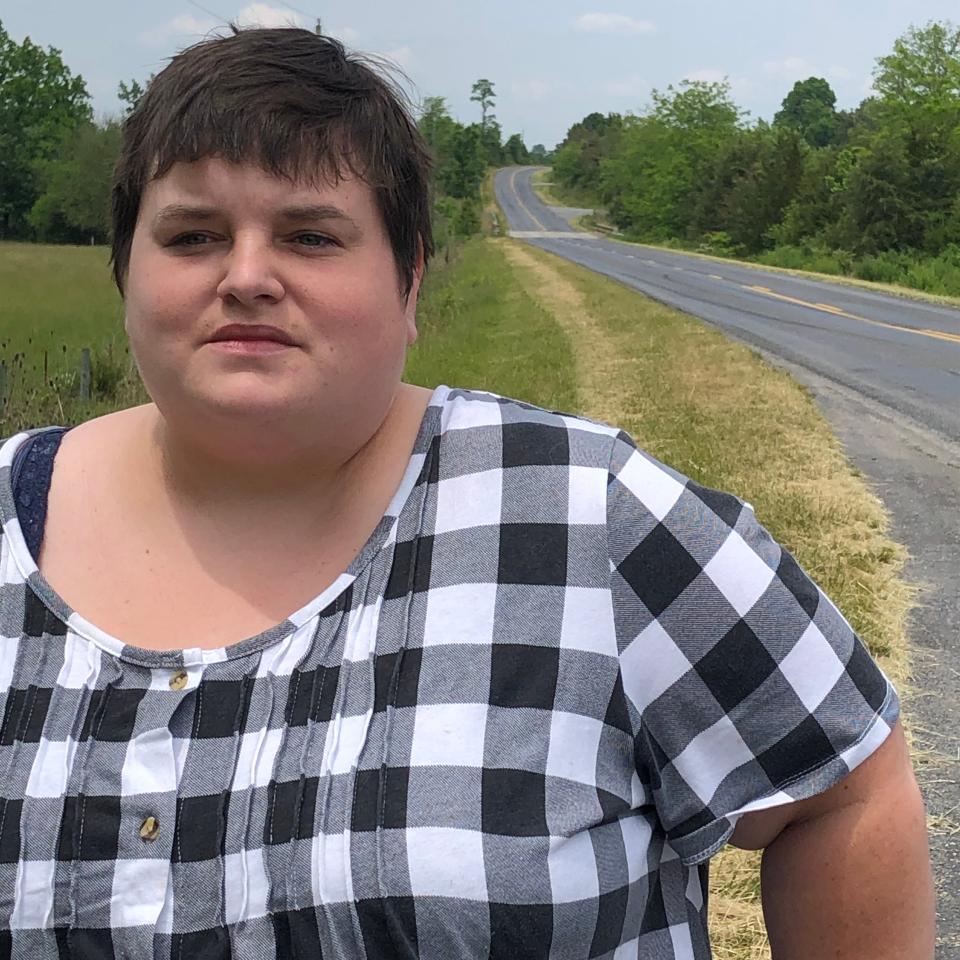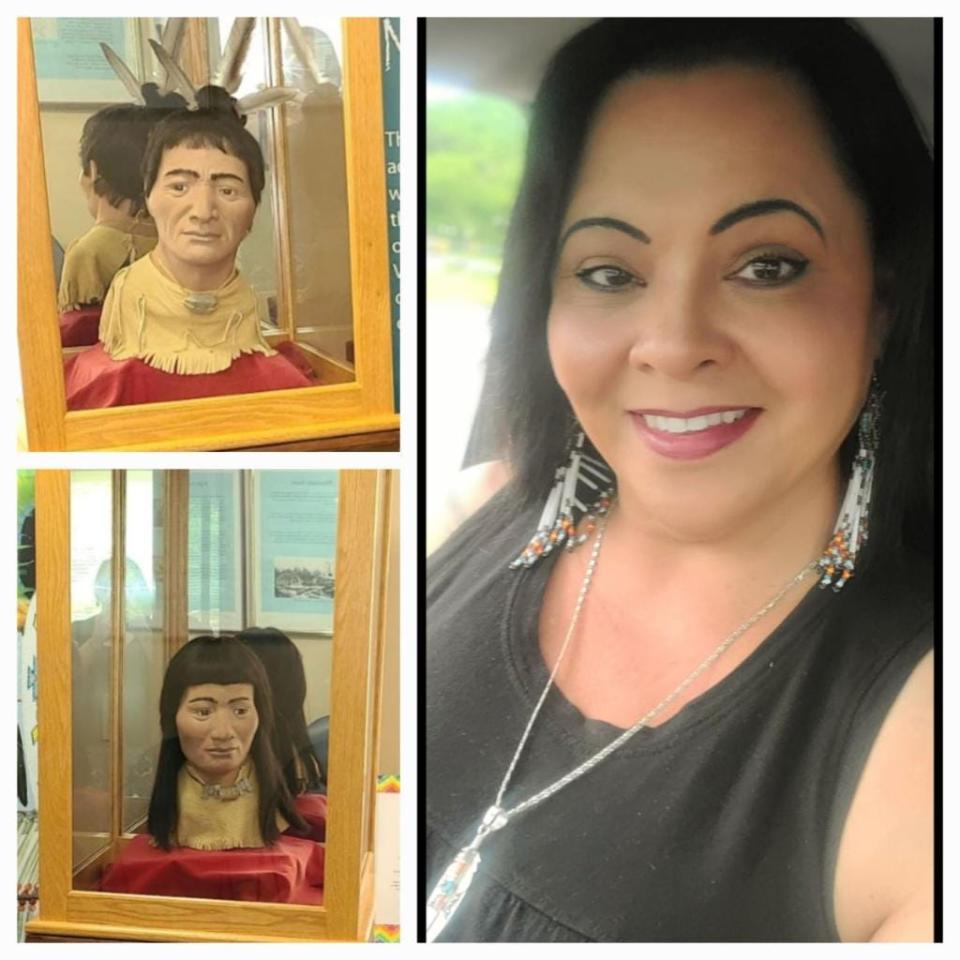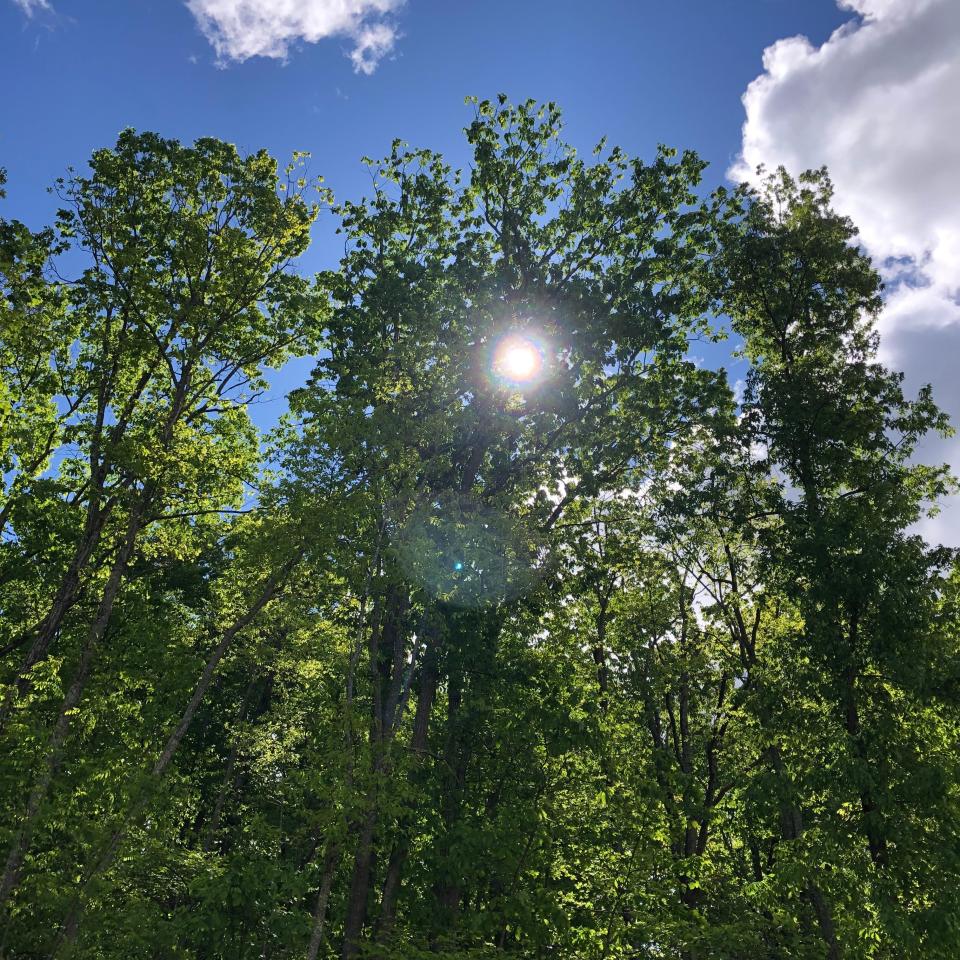800 year old infant taken from a Verona burial mound may finally come home. With one inexplicable — and perhaps illegal — change.
PART ONE — The Mystery of Indian Mound Road
If you ever want to know what it’s like to step on someone’s grave, then drive south on Indian Mound Road at 55 miles an hour. Cross the short Lewis Creek bridge, all of its three car-lengths. About 65 feet beyond it, the road you’ll cover in a fraction of a second is the site of what used to be a burial mound for the Monacan Indians.
In that fraction of a second, you’ll have driven over the ground where 500 people were buried. Men and women of all ages. Children, too, dozens of them.
At that point Indian Mound Road, also called state route 792, sits on raised land about 10 feet higher than the floodplain on either side. That actually puts your tires right around the same height the mound was 150 years ago.
It’s grave-stepping, American roadster style. Which carries a certain fitting irony: While the mound was poked into countless times by artifact seekers and even the site of an amateur excavation in the 1930s, it was the desire in 1964 for a new road to cross Lewis Creek and connect Laurel Hill Road to Hermitage Road which led to a construction plan that drove that new road smack through the middle of the Monacan mound.

Dozens of complete skeletons were dug up and packed into boxes. Hundreds of loose bones from the tribe’s ceremonial group reburials were packed together in another set of containers. Artifacts found in the individual burial areas such as weapons, tools and decorative or ceremonial objects were collected into another set, without regard for which remains they had been found beside.
In the mid-19th century the mound was higher than a horse. By 1964 the mound’s center had been desecrated so many times it stood barely two feet above the ground.
All the human remains and artifacts were cataloged and then taken away.
All except one: an intact skeleton of a 1-year-old child, found near the edge of the mound, surrounded by beads and shells. She was taken 17 miles up Route 11 to Bridgewater College.
This was the one child who, despite the destruction of her people’s resting place, has stayed all this time on Monacan land. Who was she?
***
You slept such a long time.
Tell me again what I missed.
You may not remember much from your days here, but surely you remember the sound of water. The creek by which you were born. The fields of flat rich soil from which maize seemed to sprout overnight, so tall and full in your eyes that would see each season only once, and beyond those stalks swaying in the breeze stood the steep tree-filled hill, and beyond that more hills, and beyond that the great mountains that broke the sky.
You would have looked up from your mother’s breast and seen over her head the arching young tree limbs that supported the walls and ceilings of your longhouse. You would have smelled the smoke that drifted out of the hole in the roof and into the dark night. There’d be fish and rabbit and fruits and nuts the land provided. The maize cultivated ensured a supply of food year round, supported your people as they spread across the valley.
They would glimpse the sun rising over the ancient mountains across the field, and setting over the distant mountains across the river. They saw countless days here. My people’s time in this valley is the blink of an eye of yours. Eyes that glimpsed this world 10,000 years before any others.
I can’t tell you how you died. That runs beyond my learning and my books and even the people who visit me in my dreams since your story was brought to me. But after you died they took you to the earthen mound to be with your ancestors. You were adorned with necklaces of beads and shells, some of which had been carried hundreds of miles from an ocean you’d never see, and traded here beneath the shoulders of the mountains.
At the edge of the mound they placed you, in a sitting position, knees tucked up, arms hugging your legs. You weren’t buried in a group like many of your ancestors were, part of a ritual reburial celebrated every few years to remind us, maybe, that we all are one, all share the same beginnings and endings. You had your own place. Maybe because of who your mother was, maybe just because you’d seen so little life of your own that they wanted to give you a special place looking out at the world you’d missed.
Hundreds of years passed, child. Two hundred, three hundred, five hundred years. They passed but you remained the same. Looking out at those who lived longer lives, died, and joined you.
Whatever head-dress or necklace or ceremonial clothing you wore became part of the mound, as did the flesh of your body. The beads and shells remained, gently sprinkled among your bones. The people who tended the mound, the people who planted the maize, lived and died generation on generation.
During that time the mound of the ancestors grew.
Even as it sank into the floodplain less than a hundred feet from the creek, it grew taller still. Six hundred years after you last scrambled on all fours between the legs of your parents, the mound stood higher than a man on horseback, according to the family of Virginians who’d taken up farming on the very ground where your waterside village once was.
By that time the village was gone. Most local colonial records say the village was not known to colonists, and its people had departed well before the white man came to build here.
But it takes a lot to make a community leave its dead behind. That’s a story for another time.
After your people left, the new inhabitants gave the land their own names. They named the running water Lewis Creek, and the town Verona. They took up the plough. The mound continued to sink into the earth. It would grow no higher. One farmer scraped soil off the mound’s crown to use as fertilizer. People came at night with lanterns, in search of pottery, arrowheads, pipes and eagle talons to sell or give to their friends.
Then in broad daylight a group of men came. And they began to dig. They dug through the mound’s layers and sifted through the loose dirt and put all the bones together, regardless of where they were found. They sifted through sand for artifacts separated from the dozens of individual burials they found. And they examined the bones and tested the bones, and wrote about the histories they thought the bones offered. After all that, they sent the dead to a museum to be stored. All except you.
You, they took to another place.
But tell me again how I might come home.
The amateur historian adopted a cat, and a mystery. Twelve years later, she’s still wrestling with both.
November 4, 2010 was a big day for Rebecca Jarrett. She was driving to pick up the newest member of the family.
Bastet. She’d already determined the name. The Egyptian god of protection, the daughter of the sun-god Ra. The cat-headed woman.
And, after all, the new member of the family was a cat.

From Grottoes she’d driven down the interstate to Verona, all of the quarter of an hour trip with the hulking Blue Ridge mountains so omnipresent to the east that many in that small town of 2,000 people hardly notice them. On this day, November 4, 2010, their peaks were unseeable above the heavy gray clouds threatening rain.
Protection. She might not have thought about Bastet’s special power in those moments as much as she thought about the human with a cat’s head. Why Rebecca Jarrett was thinking about a cat-headed god at all was her long curiosity about history.
As a child she often played outside, wondering who the first people who lived here were, trying to imagine their lives and relive their adventures. Who was here before me? That question never went away, but it was buried by school, then a job, and another, and all that adulthood brought.
Rolling up the exit ramp off Interstate 81, she peered through the drizzle on the windshield for the first right turn off Laurel Hill Road. There it was: Indian Mound Road. And right beyond it, the yellow barn where the god of protection awaited her new companion.
That little girl in her started asking questions. Indian Mound? Here, in Verona? Well, where is it? Let’s go see it! The child and the historian were momentarily hushed as the business of adopting a cat commenced.
With Bastet safely ensconced in a cat carrier on the passenger seat, Rebecca pulled out of the driveway and stopped at the intersection, she looked up at the street sign once again. There’s a story here, she thought.
It wasn’t an easy story to find. After months of googling she found a reference to “the Lewis Creek Mound” in a publication by a Dr. Holland. The mound had been right there in Verona and was at one point as long as 100 feet and as wide as 50 feet. It was an ancient thing, maybe a thousand years old, based on carbon dating.
This puzzled Rebecca. If there was a burial mound, there were people living around it to bury their families. And if the mound was so huge, it means they were here for generations. So why did so many history books say that the valley was uninhabitable and nobody lived here? Why was the mound not protected as part of our natural history? Why was it gone?
She got to work on those questions. She didn’t know it would take her over 12 years to find answers.
And if there was a tribe here that buried its dead in one mound over generations, where did the tribe that made that mound go?
Turns out, some of them never left at all.
The nation that stayed
Lou Branham unlocks the door to the Monacan Museum on the tribe’s Bear Mountain land near Amherst and walks to the middle room of the small, three-room rectangular building tucked into the rolling hills of Amherst. She puts down a large tote bag with her name on it, and pulls her ponytail through the back of her red baseball cap with the three-arrowed tribal logo. “Good morning, guys!” she says.
She’s not talking to the reporter and his wife who are following her in. She’s talking to two very lifelike and life-sized heads which stare back unblinking from their glass cases. Those heads and faces were built from the skulls of her ancestors, using scientific measurements to project and sculpt their facial features.
The skulls were part of a large collection of Monacan remains returned to the tribe in the early 1990s by the Valentine Museum in Richmond. They acted soon after the passage of NAGPRA, the Native American Graves Protection and Repatriation Act which became law in November of 1990. That law states that institutions, museums and schools that receive public funding had to work to identify the owners of those native remains and artifacts in their possession and make arrangements to repatriate them to their rightful owners.

Until such time as that occurred, the remains and artifacts had to be removed from display as a sign of respect for the dead and their descendants. Under the Act, a Committee was formed to advise those same institutions on next steps should they be unsuccessful in their first efforts to identify the cultural owners of the artifacts.
Private museums like The Valentine were not legally subject to NAGPRA. Still, The Valentine wasted little time in contacting the Monacans and returning the human remains and artifacts that their founder had excavated himself around the turn of the 20th century from another Virginia burial mound.
Branham, the museum director and main public contact for the Monacans — her name is one of the six most important family names in the tribe’s modern history, among those who purchased and settled Bear Mountain over a hundred years ago — was 19 when her people got state recognition in 1989. She was instrumental in the work over the next 29 years to gain the tribe its federal recognition.
The modest building housing the Monacan museum stands next to a small one-room schoolhouse where Monacan children were educated for decades in the 20th century before they were allowed in public schools in 1969. Behind the buildings, wooden walking bridges cross a narrow creek that has carved its path through smooth solid rock leading the way to an Episcopal church owned by the tribe. People here to visit the museum park on a grass slope leading down to the creek.
All around them is the sound of water.
Branham is largely responsible for the operation of the Monacan museum on a daily basis and teaches the historical significance of her people and its history here in VA. Branham has also been instrumental with other tribal members who serve on the Monacan NAGPRA committee, who have led many repatriation efforts since the tribe became federally recognized. Bridgewater is the latest, and like all NAGPRA “negotiations” there’s a sense of the tenuous nature of dealing with a culture that has never abided by its agreements. It’s part of what made the Valentine repatriation so important.
Branham remembers the turn of the last century, when she first saw the completed models sculpted from the skulls that now lay in the tribe’s Bear Mountain burial mound, built specifically to repatriate its people’s remains. She picked one up, felt the fully human features beneath her fingertips, the wide forehead, the cheekbones, the strong jaw line. She closed her eyes. “I’m holding the face of one of my ancestors,” she thought.
She named them Resilience and Pride. They watch over the displays in the room, and the plaques describing the tribe’s 10,000 years of residence in what’s now known as the Valley and Ridge and the Piedmont regions of Virginia.
Resilience and Pride were excavated from one of 13 burial mounds in the area that by the early 1990s were widely known to delineate the territory and range of the Monacan people over a time period of roughly 1000 A.D. to 1600 A.D. The four oldest of these are west of the Blue Ridge and show evidence of having each been used for periods of hundreds of years. The culture of the Monacans would spread east over the Blue Ridge to the Piedmont region, where more mounds were built and maintained.
None of those mounds remain today. Between casual pillaging, amateur “excavations” and academic or institutional digs, there’s nothing left of them.
Rebecca Jarrett’s research would eventually turn up more information on the Lewis Creek mound than even the custodians of the Lewis Creek infant’s remains knew, including a devastating history of decades of the mound’s desecration and of a last-minute excavation to remove the entire mound before the state department of transportation built a road right through it.
In that last excavation, most of the remains and artifacts recovered found their way to the Museum of Natural History in Washington, D.C. The one ancestor who went a different way was the infant. That complete skeleton and the beads and shells found surrounding the body were given to Bridgewater College’s Reuel B. Pritchett Museum in 1964.

The child’s skeleton would be on display for nearly three decades, just miles up the road from the mound site. Because the college museum was subject to NAGPRA (the Natural History Museum is not), the location would give Branham and the Monacans a chance to request the repatriation of the child — once they found out about its existence.
That would take a long time to happen. After taking the infant’s remains off display in 1992 to comply with NAGPRA, what Bridgewater College did over the next 30 years would complicate repatriation efforts. Years went by without the college reaching out to Monacan people, even though as early as 2010 the Code of Federal Regulations allowed institutions to reach out to non-federally-recognized “tribes that are recognized as aboriginal to the area from which the human remains were removed” when it came to “unidentifiable remains.”
Delay wasn’t the only problem that kept the 800-year-old infant from returning home.
***
What is this new place?
It feels like the blink of a bear’s eye, so little time has passed, but you’ve been for 30 years here in this new place. In this strange house called a museum. People have come to look at you. They watch you through walls they can see right through as if the walls were made of air.
You arrived still sitting in a box of the earth that surrounded you, and a few of the beads that adorned you when you were buried, so there’s some comfort here, but not much.
But now you’re being moved.
Into another container. Smaller than the one your parents stored maize in outside your home. You’re not the only one. Something is thrown into your space. Fragmented bones roll like dice beside you and come to rest. You feel the lives once lived of others, hear strange tongues speaking their confusion. Through the cracked sockets of your skull you sense there are even more, in other containers. Then you’re moving.
First slowly, like being carried in your father’s arms. A man. He does not relish this job. Then into a dark place, and a sudden jolt and you’re going quickly now. A new hum you’ve never heard, like the earth is singing a song in a low voice, or the mountain’s black tongue rolling up beneath you to bring you someplace else and spit you out.
Then there’s light. More words from outside the containers you and others are in. Some laughter, maybe. They take you inside. It is a good thing you no longer have your eyes now.
Then all is suddenly still. Another sound you have never heard, like stone on stone. A clicking like a crow tapping its beak on a branch. Then a whoosh, then a sound you do remember. Except much louder, and all around you, like a roar.
The sound of fire.
This article originally appeared on Staunton News Leader: 800 year old infant taken from a Verona burial mound may finally come home. With one inexplicable — and perhaps illegal — change.

